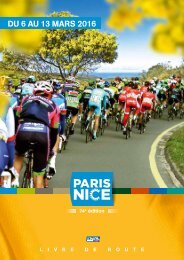tirreno_adriatico_2015
tirreno_adriatico_2015
tirreno_adriatico_2015
You also want an ePaper? Increase the reach of your titles
YUMPU automatically turns print PDFs into web optimized ePapers that Google loves.
degli artisti di strada” (settembre); la “Festa Pic: gastronomia, cultura e peperoncino” (ottobre). Citazione<br />
a parte merita la solenne processione di “Gesù Morto”, che si svolge ogni tre anni il venerdì di<br />
Pasqua: migliaia di lumini ad olio rischiarano le strade e le case del centro storico, creando un’atmosfera<br />
dalla suggestione e dalla spiritualità uniche. Tradizione significa però anche gastronomia ed anche su<br />
questo fronte Camaiore si contraddistingue per la ricchezza e la varietà di tipicità locali, quali la zuppa alla<br />
frantoiana, la torta di pepe, la torta al cioccolato e la scarpaccia. Tutto questo è il frutto di una storia<br />
che comincia da molto lontano, addirittura dall’epoca preistorica, come rivelano i siti archeologici di<br />
grotta all’Onda e Candalla. Nel medioevo Camaiore fu importante tappa di sosta lungo la Via Francigena:<br />
i pellegrini trovavano riparo e ristoro nel vicino monastero benedettino della Badia di S.S. Pietro e Paolo,<br />
splendido esempio di architettura romanica.<br />
Camaiore conserva ancora parte delle antiche mura e mantiene la vecchia pianta urbana il cui cuore è<br />
costituito da piazza San Bernardino, con il municipio e la collegiata.<br />
From the turquoise blue waters of the Tyrrhenian Sea to the emerald green hills, surrounded by the Apuan Alps, the<br />
Municipality of Camaiore is a microcosm of contrasting yet harmonizing colours, all the shades of a territory ranging<br />
from the mountain to the sea. A land whose many flavours and traditions reflect the character of its dwellers: strong<br />
yet friendly, lively and welcoming. “Popular culture” is kept alive and passed down by the many folkloristic events that<br />
take place throughout the year, including: “È la via dell’orto”, an event dedicated to vegetable gardens, seeds and herbs<br />
(April, first decade); “Coloured sawdust carpets” (during the Corpus Christi Feast); the “Festival Gaber” (July, dedicated<br />
to the unforgettable Italian singer Giorgio Gaber); “Follie d’altri tempi”, a market exhibition of antiques, modern art,<br />
vintage vehicles and spare parts (mid-August week); the “Festival degli artisti di strada” (Buskers’ Festival, September);<br />
the “Festa Pic”, celebrating culinary arts, culture and chilli pepper (October). Special mention should be made of the<br />
solemn “Triennale del Gesù Morto”, a procession commemorating Jesus’ death, taking place every three years on Good<br />
Friday: thousands of small oil lamps light up the roads and the houses of the old town, creating a uniquely suggestive<br />
and spiritual atmosphere. Tradition goes hand in hand with cuisine. Camaiore can boast a rich and varied array of local<br />
delicacies, such as zuppa alla frantoiana (a vegetable soup), torta di pepe (a typical savoury pie), a tasty chocolate<br />
cake and scarpaccia (a zucchini quiche). All this is the result of a long history, starting in prehistoric ages, as revealed<br />
by the Grotta all’Onda and Candalla archaeological sites. In the Middle Ages, Camaiore was an important station of<br />
the Via Francigena: the old “Badia di S.S. Pietro e Paolo” Benedictine monastery, nearby, an outstanding example of<br />
Romanesque architecture, provided pilgrims with shelter and food. Camaiore has maintained part of its ancient walls<br />
to the present day, together with its old urban layout whose centre is represented by Piazza San Bernardino, hosting<br />
the town hall and the collegiate church.<br />
31



